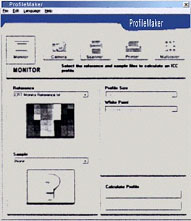1. Why monitor calibration?
The display is a window for people to talk to the computer. However, the contrast, brightness and color rendering of the monitor will be attenuated after a period of time, resulting in inaccurate display color. The display color is not allowed to bring great inconvenience to people's work, especially in industries where the requirements for color accuracy are high (such as printing, advertising, design, etc.). If the color seen on the display is very different from the printable color, the color work will not find the direction. Therefore, it is necessary to calibrate the monitor after a period of time.
In general, the better the display, the better the color rendering, the slower the attenuation, the better the display calibration effect; the worse the display, the poorer the color rendering, the faster the attenuation, and the calibration of the display will not reach a good level. effect. Quality determines the ability.
2. Monitor calibration
1) Required hardware
Spectrolino or Eye-One and other products.
2) The required software
ProfileMaker, Eye-One Match, etc.
3) Calibration of the display (taking the combination of Spectrolino and ProfileMaker as an example)
(1) Install ProfileMaker software and connect the hardware Spectrolino.
(2) Open the ProfileMaker1/Select Monitor item, where you can calibrate the monitor and create the ICC of the monitor. In the Reference, select the type of monitor you want to calibrate: CRT (Cathode Ray Tube); LCD (Liquid Crystal Display). Sample select SpectroLino. Then, follow the on-screen instructions and proceed step by step.

(3) Follow the on-screen instructions
A. The software prompts you to calibrate the SpectroLino on the white point.
B. Ask if you need to correct the display, and select “Yes†if it has not been corrected beforehand.
C. Expected corrected color temperature then appears: 6500K; Gamma: 2.2 (PC), 1.8 (MAC); Brightness: 100%.

D. The next step is to first adjust the display contrast to the maximum and absorb the food on the display. Press Start and the software will automatically adjust until the two small triangles are aligned.
E. Next Step: To minimize the brightness of the monitor, press Start and then manually adjust it to increase the brightness little by little until the two small triangles are aligned.

F. Next step: If the monitor can adjust the RGB tristimulus value, or color temperature value, then press Start, the food will measure the current RGB value and color temperature value, and then adjust the monitor RGB value, let the color temperature value to 6500K, and RGB three-color The small triangles are all centered, and there is one more critical point, which is to make the brightness value 100 (the ideal range is 80~120). If you exceed this range, it may lead to undesirable effects.

G. After the calibration is completed, it will prompt whether to recalibrate or not. Select “Noâ€.
H. Then start the ICC measurement of the screen and save it after finishing.
I. ICC can be generated by making the necessary settings. Default setting: Default (Alternatively select Large, larger data size, the effect will be better), Measured white Point.
If it is a new monitor, you can select either D65 or D50, but if RGB cannot be adjusted, or if the color temperature cannot be high, Measured White Point must be selected.
J. Click Start to generate the monitor's ICC.
K. The software asks whether to set this ICC to the system default ICC, and selects "Yes". The Monitor.icc of the monitor is automatically copied to the following address: Winnt/System32/spool/drivers/color (PC) for system calls. 
(to be continued)
Create a free-standing tower of foliage in any patch of soil. Plant Supports range in size from small ones that can be used in planters to larger ones that can be used as garden centerpieces.
You've carefully supported your prize hollyhock with a bamboo stake, but wouldn't you know - the stake buckled and now your beautiful flowers are lying on the ground. Forever free yourself from the heartbreak of feeble stakes with these Titan Garden Stakes. Thanks to a strong steel core, these stakes stand unbendingly upright and they stay that way through wind, weather and weighty plants. Plus, they're sealed in a durable polyurethane coating for lasting good looks - even the color is consistent throughout the thickness of the coating, so scratches and scrapes won't show. Use one stake to shore up a lolling sunflower, several to keep a flopping tomato on the up and up, or string several together as an impromptu fence.
Tall Steel-Core Garden Stakes Stand Stronger Longer
Plant Support Stakes,Plastic Stake,Garden Plant Stakes,Plant Support Sticks
Tianjin Panyam Garden & Horticultural Products Co., Ltd. , http://www.panyahomegarden.com
![<?echo $_SERVER['SERVER_NAME'];?>](/template/twentyseventeen/skin/images/header.jpg)